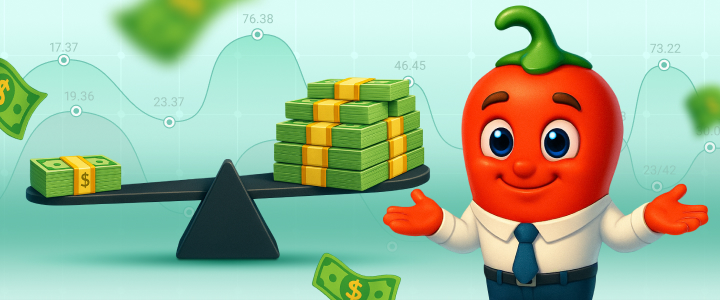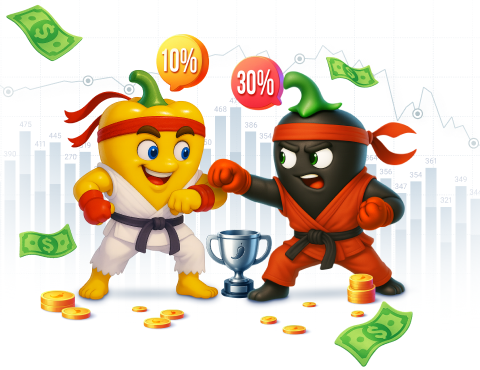Capital Management Methods for High Leverage Trading
07.08.2025
Education
Capital management methods have interested mankind for a long time. In Ancient Babylon, there was a 10.0% rule. This is the share of income that was recommended to be directed to risky investments in order to get rich.

The main difference is leverage. It has become an integral part of trading. Leverage has pushed financial mathematics forward. However, a single theory for trading has not yet been formed. There are disparate ideas. From them, everyone forms their own understanding.
When talking about capital management in trading, they usually throw everything into one heap. Myrtingale, fixed volume, anti-martingale, proportional method, averaging, pyramiding.
At first glance, everything is correct. All these words almost always appear in articles on capital management. But this is not the best approach. The task of capital management is to design an ideal ladder for us. Where each step will say at what amount and what volume to trade.
Everything else should rather be attributed to trading strategies. Doubling a position according to Martingale. Or vice versa, reducing it. Averaging a loss. Adding to a profitable position. All these are strategies for managing an already open position. But not for determining the initial volume.
Ryan Jones was the first to express such ideas. They were liked by the record-holder of trading - Larry Williams. He supported them. Now you can read about the ideas in Jones's 1999 book "Stock Market Game: Make a Million Playing with Numbers".
Despite the humorous title, the content of the book is serious. In it, he identified 2 main methods of capital management. And also formulated his approach. According to Ryan Jones, there are fixed fraction methods. This is when the trader initially determines the ratio. For example, 1 lot for every $10,000 of the deposit.
And there are proportional methods. When the risk per transaction is determined immediately. For example, 1.0% of the deposit. And with this risk, the trader calculates the volume of the transaction. John L. Kelly's formula is built into this method. Ralph Vince adapted it for trading. If the deposit is $10,000, the stop loss in the transaction is 40 points, with a point value of $10.0. Then, the appropriate transaction volume will be 0.25 lots. This will give 1.0% of $10,000.
If everything is so simple, why reinvent the wheel. Ryan Jones noticed the shortcomings of each of the methods. In the fixed fraction, he did not like the preservation of risk as the account grows. And the huge period of time before the volume can be increased. If 1 lot for $10,000. And 2 lots for $20,000. Before the volume grows, you need to double the capital. Now it is all easier. It is possible to split lots. Trade mini-contracts. But in 1999, everything was more complicated.
In the proportional method, Jones found only one big drawback. He called it the "reverse leverage effect." If you lose 10.0% of the deposit in a deal. To get it back, you need to earn 11.1%.
To improve the results, Ryan Jones needed to cross both methods. The result was a fixed-proportional one. His idea is in the steps. Each has space before the volume grows or decreases.
For example, if the initial deposit is $10,000, and the trader sets the step at $4000. Then he will receive an increase in the volume to two contracts for $14,000. $10,000 + (1 contract X for $4,000). Three contracts will be included for $22,000. $14,000 + (2 contracts X for $4,000). And so on.
You can lay down the risk through the "step". The smaller it is, the higher the risk. And vice versa. But in the case of an unprofitable transaction, the reverse leverage effect will not be included immediately. The capital will remain at the same level, even if it grows or falls.

4 thousand years have passed. The 10.0% rule is still relevant. It is promoted by financial gurus. But thanks to the development of technology, there are more opportunities. Trading has taken over the world. And it requires its own capital management methods.
The main difference is leverage. It has become an integral part of trading. Leverage has pushed financial mathematics forward. However, a single theory for trading has not yet been formed. There are disparate ideas. From them, everyone forms their own understanding.
Ideas
When talking about capital management in trading, they usually throw everything into one heap. Myrtingale, fixed volume, anti-martingale, proportional method, averaging, pyramiding.
At first glance, everything is correct. All these words almost always appear in articles on capital management. But this is not the best approach. The task of capital management is to design an ideal ladder for us. Where each step will say at what amount and what volume to trade.
Everything else should rather be attributed to trading strategies. Doubling a position according to Martingale. Or vice versa, reducing it. Averaging a loss. Adding to a profitable position. All these are strategies for managing an already open position. But not for determining the initial volume.
Comparison
Ryan Jones was the first to express such ideas. They were liked by the record-holder of trading - Larry Williams. He supported them. Now you can read about the ideas in Jones's 1999 book "Stock Market Game: Make a Million Playing with Numbers".
Despite the humorous title, the content of the book is serious. In it, he identified 2 main methods of capital management. And also formulated his approach. According to Ryan Jones, there are fixed fraction methods. This is when the trader initially determines the ratio. For example, 1 lot for every $10,000 of the deposit.
And there are proportional methods. When the risk per transaction is determined immediately. For example, 1.0% of the deposit. And with this risk, the trader calculates the volume of the transaction. John L. Kelly's formula is built into this method. Ralph Vince adapted it for trading. If the deposit is $10,000, the stop loss in the transaction is 40 points, with a point value of $10.0. Then, the appropriate transaction volume will be 0.25 lots. This will give 1.0% of $10,000.
Ryan Jones' Method
If everything is so simple, why reinvent the wheel. Ryan Jones noticed the shortcomings of each of the methods. In the fixed fraction, he did not like the preservation of risk as the account grows. And the huge period of time before the volume can be increased. If 1 lot for $10,000. And 2 lots for $20,000. Before the volume grows, you need to double the capital. Now it is all easier. It is possible to split lots. Trade mini-contracts. But in 1999, everything was more complicated.
In the proportional method, Jones found only one big drawback. He called it the "reverse leverage effect." If you lose 10.0% of the deposit in a deal. To get it back, you need to earn 11.1%.
To improve the results, Ryan Jones needed to cross both methods. The result was a fixed-proportional one. His idea is in the steps. Each has space before the volume grows or decreases.
For example, if the initial deposit is $10,000, and the trader sets the step at $4000. Then he will receive an increase in the volume to two contracts for $14,000. $10,000 + (1 contract X for $4,000). Three contracts will be included for $22,000. $14,000 + (2 contracts X for $4,000). And so on.
You can lay down the risk through the "step". The smaller it is, the higher the risk. And vice versa. But in the case of an unprofitable transaction, the reverse leverage effect will not be included immediately. The capital will remain at the same level, even if it grows or falls.
And starting from the second step, each step will be safer. At the second step, $7,000 is accounted for in the calculations for each contract. And at the third step it is already $7,333. At the fourth it will be $8,500. And so on. As a result, the growth of the deposit will exert less psychological pressure.
Conclusion
Each trader uses his own method of capital management. With some adjustments, both the fixed fraction and the proportional method can be set up. The main thing is that each professional strictly adheres to his own rules.
Popular articles
News
Education
News
Education
News
Education
Education
News
Feedbacks
Education
News
Education
Education
News
SpiceProp June Shopping Festival is ON!
26.06.2025
News
Education
News
News
Education
News
Feedbacks
Feedbacks
Education
News
Education
What is Prop Trading and How Does it Work?
29.05.2025
News
Feedbacks
Education
Forex vs. Gambling
22.05.2025
News
Last Big Sale This Spring in SpiceProp!
21.05.2025
Feedbacks
Education
News
Education
News
Education
Feedbacks
News
Last April Sale – Less Than 48 Hours Left!
29.04.2025
Feedbacks
Education
How to analyze your trading report?
24.04.2025
Feedbacks
Education
Can you start trading at any age?
17.04.2025
News
News
Education
News
Feedbacks
News
Feedbacks
Feedbacks
News
Feedbacks
News
Feedbacks
News
Feedbacks
News
Feedbacks
News
News
Feedbacks
Feedbacks
News
Celebrate Chinese New Year with SpiceProp
05.02.2025
News
Feedbacks
Feedbacks
Dionisie Florea: Achieving Trading Success
13.01.2025
News
News
News
News
News
Interview
Feedbacks
News
News
Feedbacks
Feedbacks
Marcel Surd: Earned €8,937 in Just Two Weeks
14.11.2024
News
News
News
News
News
Chilli Pepper Profit Targets Reduced to 10%
16.09.2024
News
Education
Immediate Funding – How Does It Work?
03.09.2024
Education
Top Twelve Videos Every Trader Should Watch
29.08.2024
Feedbacks
Interview
Feedbacks
Riadh Mazgou: Making Above €7,000 Profit
12.08.2024
Education
News
News
Education
Work of a Prop Trader – How to Start?
29.07.2024
Feedbacks
Interview
How investment losses help build a success
24.07.2024
Education
News
Feedbacks
Viktor Ovcharov: I Made €1990 In A Week
14.07.2024
Education
How to Become a Prop Trader?
10.07.2024
News
Education
Embrace the risk, or how to manage it
03.07.2024
News
SpiceProp’s most important facts. June 2024
30.06.2024
News
News
News
Use Your Free Reset until the end of June
09.06.2024
Feedbacks
Feedbacks
News
SpiceProp’s important events. May 2024
29.05.2024
Interview
Education
Introduction to fundamental analysis
06.01.2024
Education
The five rules of a successful trader
30.12.2023
Education
How to tame your emotions in trading
12.12.2023
Education
How to build a trading strategy
11.12.2023
Education
What is proptrading
11.12.2023
